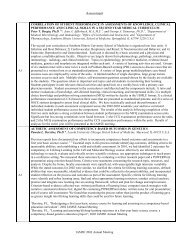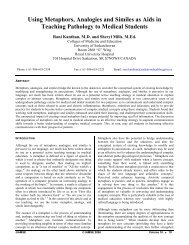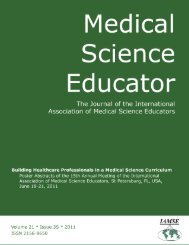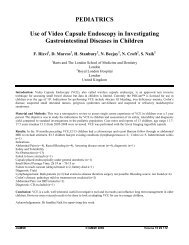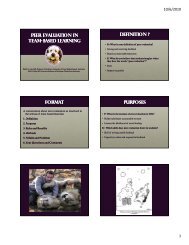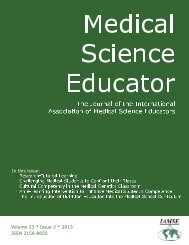Click here to view complete journal in pdf-format - IAMSE
Click here to view complete journal in pdf-format - IAMSE
Click here to view complete journal in pdf-format - IAMSE
Create successful ePaper yourself
Turn your PDF publications into a flip-book with our unique Google optimized e-Paper software.
RESULTS<br />
Student performance on Cl<strong>in</strong>ical science vignettes<br />
correlated nearly as well as the overall Med 2 scores<br />
with Step 1 results, even though vignette questions<br />
accounted for a smaller portion of the exams than<br />
recall questions. Further, performance on vignette<br />
items was more accurate <strong>in</strong> predict<strong>in</strong>g which<br />
students were at risk for USMLE Step 1 failure. No<br />
s<strong>in</strong>gle performance criterion that was exam<strong>in</strong>ed,<br />
however, provided an absolute correlation with<br />
USMLE Step 1 scores for every student.<br />
CONCLUSIONS<br />
The most accurate prediction of USMLE Step 1<br />
performance requires utilization of a comb<strong>in</strong>ation of<br />
category scores. This performance data will better<br />
identify those students at risk, and will aid <strong>in</strong><br />
evaluat<strong>in</strong>g areas of strength and weakness.<br />
Assessment Abstract ID: 109<br />
LEARNING BY QUIZ: BASIC INSTINCTS<br />
FOR BASIC TISSUES IN HISTOLOGY<br />
Raj Ettarh and David Jerrett, Tulane University<br />
School of Medic<strong>in</strong>e, New Orleans, LA 70112, U.S.A<br />
PURPOSE<br />
One rout<strong>in</strong>ely used method of evaluat<strong>in</strong>g learn<strong>in</strong>g is<br />
<strong>to</strong> test student knowledge by quiz or exam<strong>in</strong>ation.<br />
Students understand this approach - an<br />
appreciation that has led <strong>to</strong> the dictum "assessment<br />
drives learn<strong>in</strong>g". This study explored the idea that<br />
<strong>in</strong>creased frequency of test<strong>in</strong>g should cause students<br />
<strong>to</strong> prepare more frequently for assessment and thus<br />
improve learn<strong>in</strong>g.<br />
METHODS<br />
First year medical students tak<strong>in</strong>g a his<strong>to</strong>logy course<br />
were assessed, over a 3-week period, for recall of<br />
<strong>in</strong><strong>format</strong>ion relat<strong>in</strong>g <strong>to</strong> recognition of cell and tissue<br />
characteristics. Performance between tested and untested<br />
students <strong>in</strong> multiple choice <strong>format</strong>ted quizzes<br />
adm<strong>in</strong>istered prior <strong>to</strong> and immediately follow<strong>in</strong>g<br />
each his<strong>to</strong>logy labora<strong>to</strong>ry, and <strong>in</strong> practical and<br />
written components of one summative exam<strong>in</strong>ation,<br />
was evaluated.<br />
RESULTS<br />
In tested students, t<strong>here</strong> was an improvement <strong>in</strong><br />
post-lab quiz performance over pre-lab performance<br />
<strong>in</strong> 50% of quizzes. Tested students demonstrated<br />
better recall of <strong>in</strong><strong>format</strong>ion for identify<strong>in</strong>g cell and<br />
tissue characteristics <strong>in</strong> the practical component of<br />
the summative assessment than they showed dur<strong>in</strong>g<br />
quizzes but t<strong>here</strong> was no significant difference <strong>in</strong><br />
this ability or <strong>in</strong> recall of didactic <strong>in</strong><strong>format</strong>ion when<br />
compared <strong>to</strong> students who were not quizzed <strong>in</strong> lab<br />
dur<strong>in</strong>g this period.<br />
CONCLUSIONS<br />
These f<strong>in</strong>d<strong>in</strong>gs suggest that quizzes are useful for<br />
identification skills and knowledge acquisition <strong>in</strong><br />
his<strong>to</strong>logy but the use of quizzes may need <strong>to</strong> take<br />
account of other fac<strong>to</strong>rs and circumstances <strong>to</strong><br />
achieve benefits for students.<br />
Assessment Abstract ID: 110<br />
ACADEMIC PERFORMANCE OF FIRST<br />
YEAR MEDICAL STUDENTS IN TAMIL<br />
NADU, INDIA<br />
Mayil Vahanan Natarajan 1 , Sivasangeetha K 2 , R.<br />
Srilakshmi 3 , S. M<strong>in</strong>i Jacob 4 , Mohan Das Joe<br />
Chandra 4 . 1 Vice Chancellor, The Tamil Nadu Dr<br />
MGR Medical University, Chennai, India<br />
2 Controller of Exam<strong>in</strong>ations, The Tamil Nadu Dr<br />
MGR Medical University, Chennai, India<br />
3 Registrar, The Tamil Nadu Dr MGR Medical<br />
University, Chennai, India 4 Deputy Controllers of<br />
Exam<strong>in</strong>ation, The Tamil Nadu Dr MGR Medical<br />
University, Chennai, India<br />
PURPOSE<br />
T<strong>here</strong> are 27 Medical Colleges <strong>in</strong> Tamil Nadu<br />
affiliated <strong>to</strong> Tamil Nadu Dr MGR Medical<br />
University. The different components of the<br />
exam<strong>in</strong>ations <strong>in</strong>clude Theory, Viva voce,<br />
cl<strong>in</strong>ical/practical and <strong>in</strong>ternal assessments. The<br />
objective of this study was <strong>to</strong> assess the exam<strong>in</strong>ation<br />
performance of 1st year MBBS students aga<strong>in</strong>st each<br />
component as per the University regulations and <strong>to</strong><br />
compare the results with the national medical<br />
exam<strong>in</strong>ation guidel<strong>in</strong>es of India.<br />
METHODS<br />
Medical Students scores were collected from the<br />
database after the exam<strong>in</strong>ations for the follow<strong>in</strong>g<br />
subjects of Ana<strong>to</strong>my, Physiology and Biochemistry.<br />
Each had Paper I and II. A candidate is said <strong>to</strong> have<br />
passed <strong>in</strong> a subject if he/she has scored 50% of<br />
marks <strong>in</strong> each component as per University<br />
guidel<strong>in</strong>es. We compared the scores aga<strong>in</strong>st the<br />
national medical exam<strong>in</strong>ation guidel<strong>in</strong>es w<strong>here</strong> <strong>in</strong><br />
each of the subjects, a candidate must obta<strong>in</strong> 50% <strong>in</strong><br />
aggregate with a m<strong>in</strong>imum of 50% <strong>in</strong> Theory<br />
<strong>in</strong>clud<strong>in</strong>g orals and m<strong>in</strong>imum of 50% <strong>in</strong> practical.<br />
RESULTS<br />
On the whole 3173 students appeared for the<br />
exam<strong>in</strong>ation <strong>in</strong> August 2011. Sixty three percent<br />
were from Government colleges and 37% were from<br />
private <strong>in</strong>stitutions. The overall pass as per<br />
University regulations was 60% (Ana<strong>to</strong>my 76%,<br />
Medical Science Educa<strong>to</strong>r © <strong>IAMSE</strong> 2012 Volume 22(4S) 277



